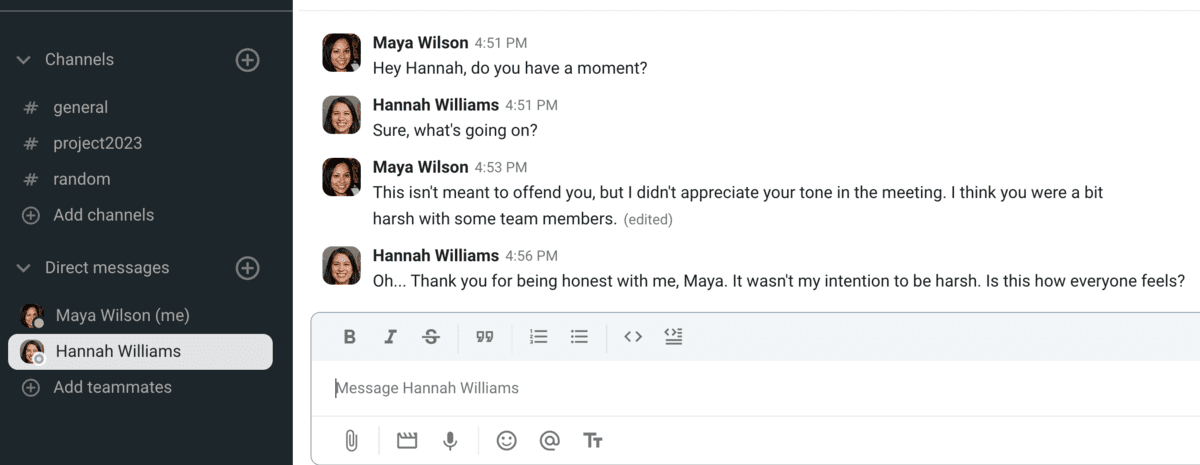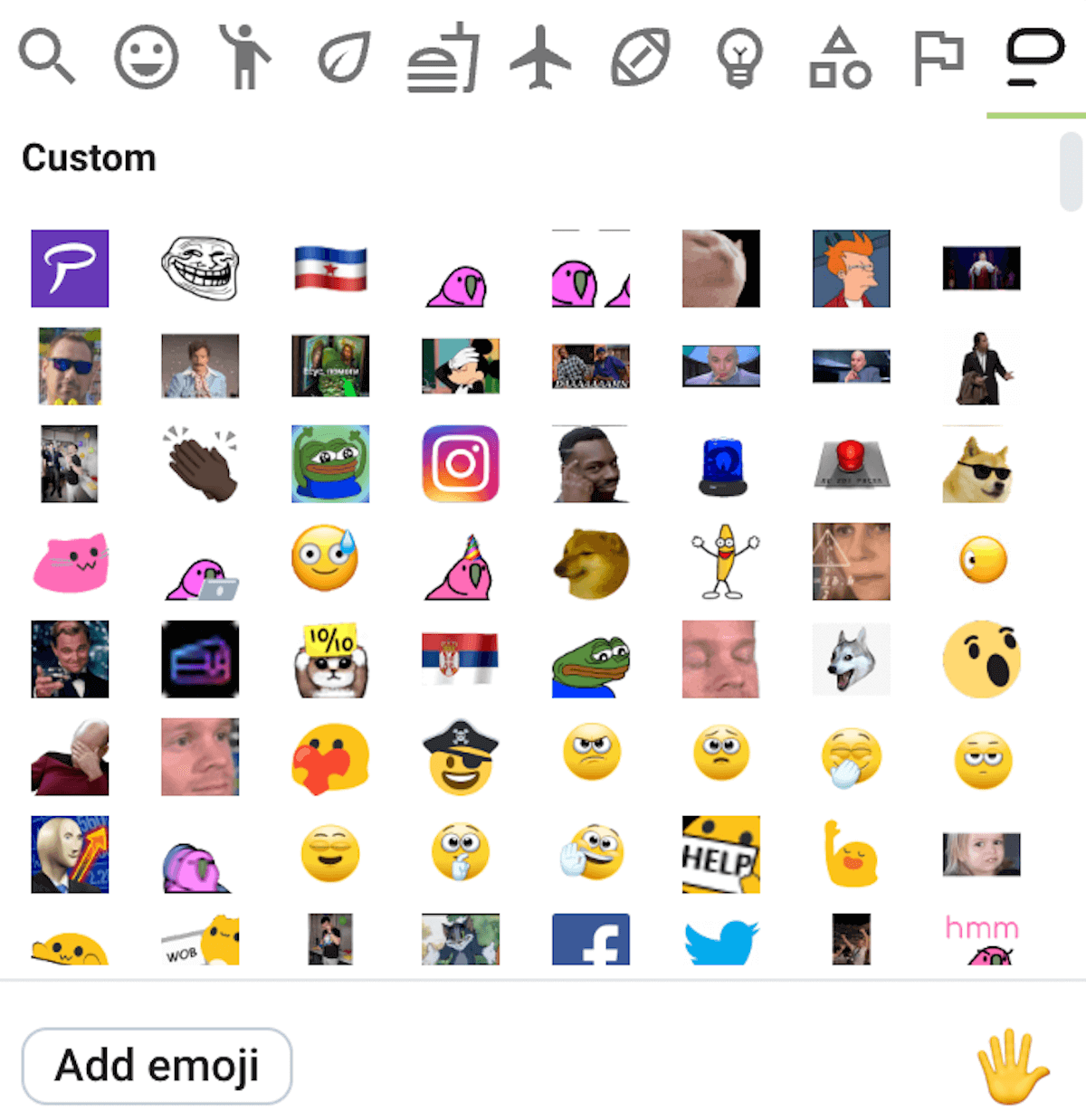As we all know (sadly, often from experience), you can’t always have a positive work environment.
And, it’s not the lack of office happy hours and free gym memberships that causes a workplace to be toxic — but the difficult people who work there. The absence of good team communication is typically a leitmotif in such environments.
In this blog post, we’ll go over 6 steps to help you deal with difficult coworkers and (hopefully) stay sane while doing so.
Let’s get right into it.

- Focus on your reactions and behavior.
- Don’t take it personally when someone is being difficult.
- Try to communicate about the issue and consider both sides of the conversation.
- Take care of your mental health when dealing with difficult people.
- Reach out for help if nothing else works.
Table of Contents
#1: Determine the type of difficult coworker you’re dealing with
There are different types of difficult people, so your first step is to troubleshoot the problem.
What makes your coworker difficult to deal with? Are they:
- Rude,
- Arrogant,
- Dismissive,
- Bossy,
- Always late,
- Micromanaging the team,
- Stealing your ideas and presenting them as their own, or
- Just plain annoying?
Understanding what exactly bothers you is crucial to determining your strategy and deciding how to handle the situation.
According to Michael Moran, the Recruiting Manager and Owner of Green Lion Search Group, you should identify the reason behind the behavior to help you decide what you can do:

“The first step is to define for yourself the specific behaviors or attitudes that make the individual difficult to work with.
Next, put yourself in the other person’s shoes, and try to identify the motivation and intent behind the behavior. Identify where the other person is coming from and what they’re hoping to achieve by acting the way they do.
This will also help you gauge if you’re dealing with objectively hostile/toxic behavior or if it’s more a personality clash or pet peeve.”
#2: Focus on what you can control
Trying to change others to fit our needs and expectations is a losing game. As is the case with most things in life, we simply don’t have control over others and their behavior. However, there is something we are in control of — our reactions, responses, and behavior. Therefore, we should focus on that.
We spoke to Dr. Simon Karmarkar, Gestalt Therapist, Doctorate in Management with emphasis on Organizational Leadership, Author, and Public Speaker. He shared how we can take an introspective approach when dealing with difficult people:

“The first step to face difficult workers starts with conducting a self-assessment or CDIL (Character Defect Inventory List).
In just about every business, a regular inventory is taken and items that have expired or are about to expire are discarded. With this step we are doing the same thing with our defects, thereby raising our emotional intelligence quotient. The individual takes a rigorously honest look at what is in them that might be causing some internal friction.
With this introspective step, the individual identifies how he or she is showing up or presenting oneself. The natural progression to this step is being armed or prepared to respond, as opposed to reacting when interacting with “difficult people.”
Focusing on your own behavior and actions will enable you to react to difficult situations with patience and composure, instead of losing your cool and lashing out. In the process of trying to deal with a difficult coworker, you shouldn’t become one yourself.
💡 Pumble Pro Tip
Introspection requires maturity and emotional intelligence. If you want to learn more about why emotional intelligence is important in the workplace, and how you can improve it, read our blog post:
#3: Don’t take it personally
You thought about the situation and you’re fairly sure you’re not the problem — you did your best to be professional, helpful, and kind. It’s your coworker who’s creating the issue.
But, why do they behave that way?Well, there’s a myriad of reasons why. They could be going through a stressful period. Or, they could genuinely be an unpleasant person. Either way, it’s likely that it has nothing to do with you — so, don’t take it personally.
We spoke to Raele Antano, a Certified Communication Coach and Founder of Well With Raele Coaching, to find out what makes people difficult to communicate with.
She agrees that it’s almost always their own problems that cause issues:

“What makes people difficult to deal with is almost always their own thoughts, emotions, and fears. Their fear of being vulnerable with colleagues. Their fear of being bombarded with work and inability to deal with overwhelm. Their challenges outside of work that impact their mood at work and make them unapproachable. Words and behaviors are simply a result of our thoughts, fears, and emotions.”
Ph.D. and Co-Author of the Thomas-Kilmann Conflict Mode Instrument, Ralph H. Kilmann, adds that difficult people project their problems onto others:

“Deep within each type [of difficult person] is an insecure and unhappy person, one who copes with their inner conflicts and negative self-image by projecting them onto other group members — and then attacking them for displaying those highly negative characteristics.
Indeed, troublemakers spend most of their energy surviving, protecting, projecting, attacking, and thus living out their problems on others.”
In other words, people behave through the prism of various factors, such as their:
- Character,
- Previous experiences,
- Beliefs and expectations,
- Emotional state and mental health,
- The environment they grew up in, etc.
It’s a reflection of who they are, not who you are.
#4: Communicate about the issue
Unfortunately, some people are just impossible to communicate with effectively.
However, if you think there is any chance of a productive conversation, try to have it. Confront the person about their behavior and how it impacts your work environment.
While doing so, there are a few things to keep in mind:
- Set your intentions before the conversation occurs. Don’t lose sight of what your goals are and what you are trying to achieve by having this interaction.
- Be professional and treat them with respect, but stand up for yourself if they’re disrespectful to you. You’re under no obligation to tolerate disrespect.
- Focus on the issue. Don’t focus on them as a person and the intricacies of their personality, but rather on the issue itself. Don’t think of it as you vs. them, but you (as a team) vs. the issue.
You may just resolve the issue during the conversation, so communicate the problem you’re facing and keep an open mind. Sometimes, it can just be a case of simple miscommunication — the other person may not even be aware that there is an issue.

💡 Pumble Pro Tip
Resolving conflicts is a necessary skill that will make your communication more effective. To learn more about conflict resolution, effective communication, and how to become an effective communicator, here are some resources:
#5: Explain your point of view and listen to theirs
Explain your point of view clearly and calmly. Refrain from accusing and blaming the other person, as that will only make them defensive, and your constructive conversation will be gone with the wind.
To avoid conflict and defensive responses, it’s best to use ‘I’ statements instead of ‘You’ statements.
For example, look at the difference between these two sentences:
“I feel exhausted and frustrated when I have to work on your tasks on top of my own workload, which is already quite heavy.” ✅
“You are incapable of doing your goddamn job and you have no respect for others and their time!” ❌
How to listen to a difficult coworker?
Keep the situation calm by listening actively and attentively when it’s their turn to talk. Be compassionate.
I learned a very valuable lesson in the book Never Split the Difference by Chriss Voss — everyone wants to be heard and seen. As Voss wrote:
“Psychotherapy research shows that when individuals feel listened to, they tend to listen to themselves more carefully and to openly evaluate and clarify their own thoughts and feelings.”
We explored this issue further with Douglas Noll, a Listening and De-Escalation Coach and Trainer, who believes that affect labeling is a good approach to communicating with difficult people:

“The go-to foundational skill that will work with every difficult person is known as affect labeling. Affect labeling means that, as the listener, you ignore the words, read the emotions, and reflect back the emotions with a simple “you” statement. Brain scanning studies show affect labeling to calm an angry, upset person in less than 90 seconds. As I teach my graduate students, de-escalate the difficult person, then engage them in problem-solving. Essentially, you must “listen to them into existence” before you can address the problem causing the difficulty.”
In this case, Noll refers to ‘you’ statements such as “You seem upset because you feel that your manager doesn’t appreciate your effort.”, which serve as a confirmation that we truly heard the person we’re talking to.
#6: Take care of yourself after dealing with difficult coworkers
Last, but definitely not least, take time to relax and destress after dealing with difficult people. Such encounters can be frustrating, emotionally draining, and anxiety-inducing.
I once heard someone say “I need to take care of myself, I haven’t found myself on the street” and it has stuck with me ever since.
You need to take care of yourself, as stress can negatively affect you both physically and mentally.
According to Mayo Clinic, stress symptoms can include:
- Headache,
- Fatigue,
- Sleep problems,
- Restlessness,
- Irritability or anger,
- Use of alcohol, tobacco, or drugs,
- Undereating or overeating, etc.
There are many ways to destress — pick one that you like the most and that fits your schedule and lifestyle. Here are some of the most popular and the fastest ones:
- Take a walk, preferably in nature.
- Practice breathing exercises and/or meditate.
- Do something creative (if you’re not an artsy person, you can try adult coloring books, for example).
- Vent to someone you trust — it’s best to choose a friend or a family member, not a coworker.
- Listen to some feel-good music.
- Organize a spa evening (you can do it at home, too).
- Play with your pet.
- Make a hot cup of tea and spend some time offline, just being present.
Whatever your preferred method of dealing with stress is, make sure to practice it regularly and don’t let stress build up.
💡 Pumble Pro Tip
If you’re working remotely, check out these wellness ideas for a healthier remote work environment:
Bonus tip: What to do if communication doesn’t work?
You’ve taken all the steps and tried all the strategies to deal with a difficult coworker, and it’s still unmanageable. What now?
We spoke to Andrew Lokenauth, People Manager, Finance Executive, and Career Coach, and he believes that the answer to this question is to involve your manager and HR:

“If your colleague is repeatedly rude and disrespectful, and you can’t work out a solution, you should speak to your manager for advice, as well as document your issue with human resources, to keep a record of the negative behavior.”
You should try to resolve the issue privately and turn to a higher authority only if you exhausted all the other options.
In the meantime, try to keep contact with that person to a minimum. Think if there is someone else who can take their place.
For example, if your mentor is causing you trouble, try to figure out if there’s another senior colleague who will be happy to answer your questions when you get stuck.
Michael Moran also agrees that if communication doesn’t work and if the behavior is abusive, you should reach out for help:

“The type of difficult behavior you’re dealing with will be the main factor in what step you take next if talking to the person doesn’t work. If it’s bullying, harassment, or other hostile behavior, you should talk to your manager or HR to get their help in stopping the behavior. Otherwise, honestly assess the behavior’s impact on your work environment, and what options are open to you that could minimize your contact.”
Pumble makes your workplace communication easier
Although we all know how difficult it is to find the right approach to communicate with some colleagues, it becomes much easier when we have a good communication app at our disposal.
If you don’t enjoy face-to-face communication with difficult coworkers, you will be thrilled to use direct messages and channels.
Since there is no “seen” option on Pumble, you have more time to think about the potential response in a conversation with difficult colleagues.
Also, if you notice the conversation is getting too serious, you can always relax it by using emojis or reactions as a response.

Moreover, you don’t have to go to the office if you need to meet with difficult colleagues. Simply schedule a video or audio call and discuss the matter.

Finally, if you have your own way of communicating with people you don’t see eye to eye with, you can always go through those conversations because Pumble features unlimited message history.
If all these features look appealing to you, don’t waste time! Try Pumble today!




